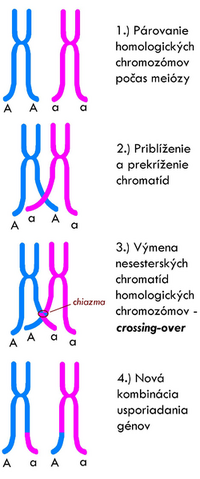Crossing-over, its mechanism and significance
Crossing-over is the process during which a piece of DNA is exchanged between two homologous chromosomes. The exchange takes place during the prophase (pachytene) in the I. meiotic division.
This process is controlled randomly; the place where both parent descriptions "split" and then "glue" together is chosen by the invisible hand of evolution.
Mechanism[edit | edit source]
'Pairing of homologous chromosomes occurs in prophase. Thanks to the synaptonemal complex, they combine into one formation called bivalent. Crossing over (recombination) of chromosome parts occurs in non-sister chromatids. A chiasm will form at this point (0-2 per crossing-over). After recombination, the chiasmata disappear and reduction division is completed.
The result of correctly executed crossing-over is the exchange of corresponding sections of chromatids and thus the exchange of alleles on these sections of localized genes between the chromatids of homologous chromosomes: i.e. disruption of the linkage of genes and the emergence of a new combination of alleles on one chromosome, which increases the variability of the offspring.
In the case of an incorrectly performed crossing over (different sections of chromatids are exchanged), a mutation occurs, the danger of which varies from case to case
- as a rule, it is a chromosomal mutation, however, if one of the chromosomes loses its centromere due to crossing-over, the entire defect can result in a genomic mutation in the daughter cells.
Recombination can be single or double. In simple recombination, only one chromatid crossover occurs, while in multiple recombination, several crossovers occur (most often 2).
Crossing-over occurs approximately once or twice for each chromosome. The exceptions are the sex chromosomes, where recombination cannot occur.
Meaning[edit | edit source]
Crossing-over is, along with mutations and the random separation of chromosomes into gametes, one of the main sources of genetic variability.
Many geneticists believe that the entanglement created by crossing-over is a way to keep members of the bivalent together during prophase I. In some organisms, prophase I is prolonged. For example, it can take up to 40 years for women. [1]
Although it does not create new alleles, it enables the creation of new combinations of already existing alleles of genes located on the same chromosome.
Links[edit | edit source]
Related Articles[edit | edit source]
Source[edit | edit source]
- ŠTEFÁNEK, Jiří. Medicína, nemoci, studium na 1. LF UK [online]. [cit. 2009]. <http://www.stefajir.cz>.



